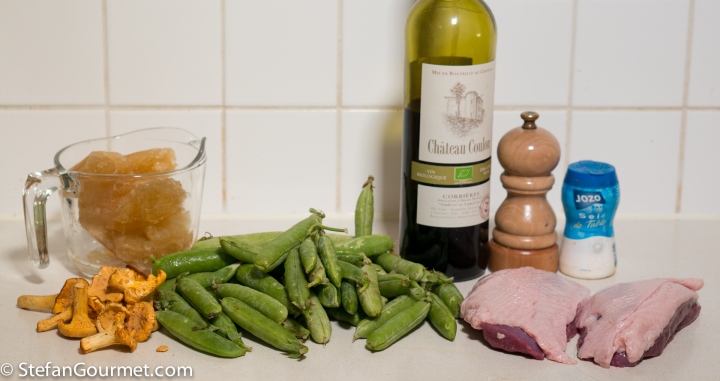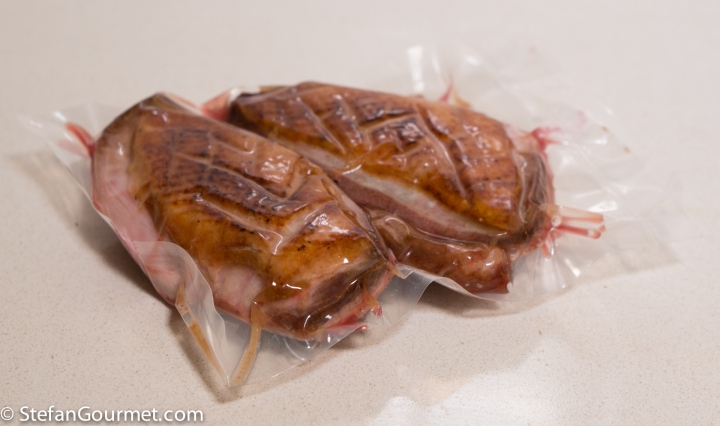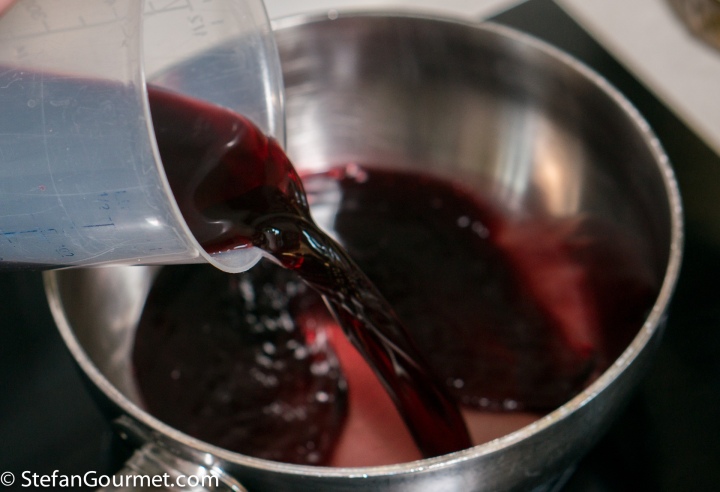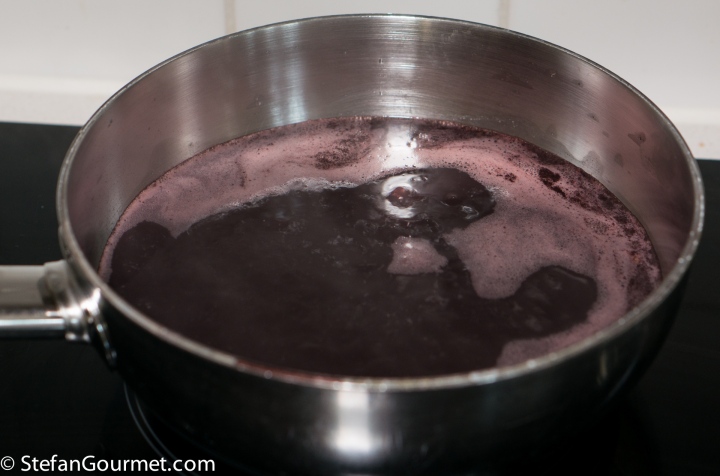Sometimes the inspiration for a dish comes from a wine that I wanted to drink with it. Sometimes it comes from what is in season. Sometimes it comes from what I see at the market (which is often the same as what is in season, naturally). This dish has a bit of all of the above. It started with a 2004 Barbaresco that I knew would work well with duck breast and a red wine reduction. Garden peas, sold in the pod, are in season, and are only available for a few weeks every year. (They are best when they are freshly picked. Otherwise, frozen peas are a great substitute.) Barbaresco works well with earthy flavors, and I saw chanterelle mushrooms at the market. And so this dish was born.
As you can see the duck breast is cooked a perfect medium/medium rare from edge to edge, thanks to the use of sous vide. But you can also finish cooking the duck breast in the oven.
Ingredients
For 4 servings
2 duck breasts, 500 grams (1.1 lbs) total weight
500 grams (1.1 lbs) peas in the pod, or 250 grams (about 2 cups) shelled peas (frozen is fine)
12 chanterelle mushrooms
500 ml (2 cups) homemade chicken stock, without salt
250 ml (1 cup) red wine
salt and freshly ground black pepper
1 tsp cornstarch or arrowroot
1 Tbsp high quality extra virgin olive oil
Instructions
Score the skin/fat side of the duck breasts in a lattice pattern, making sure not to cut into the meat. Scoring the skin will prevent it from curling up too much during cooking and will facilitate rendering the fat from the skin. Season the skin with salt, rubbing it into the lattice pattern with your fingers. Do not season the flesh side yet.
Render the fat from the skin in a dry frying pan (i.e. without oil or butter) over medium-high heat. If the heat is too high, the skin will burn before enough fat has rendered from it. If the heat is too low, the flesh will be cooked too much before enough fat has rendered from the skin, or the skin won’t become golden brown. This takes a bit of practice. Check the skin regularly and keep going until it is nicely browned, not burnt.
Right before you turn the breasts, season the flesh side with salt.
Turn them, and cook very briefly on the flesh side, just enough to give them a nice sear.
Allow the seared duck breasts to cool on a plate.
Reserve the pan with the rendered duck fat to cook the mushrooms later on.
To finish cooking the duck breasts in the oven, put them in an oven at 160C/325F until the core temperature reaches 55C/131F. Then take them out of the oven and allow them to rest, wrapped in aluminum foil, for 5 to 10 minutes.
To cook them sous vide, allow the breasts to cool completely, and then vacuum seal them. (Only if you are using a ziplock bag, it is not needed to allow them to cool first.) Cook sous-vide for at least 2 hours at 57C/135F. I prefer to cook them for 4 hours or so, as that will make the meat more tender.
To make the red wine sauce, pour the red wine into a saucepan.
Add the chicken stock.
Bring to a boil, then reduce the heat and simmer, uncovered…
…until reduced to about a quarter.
Meanwhile, shell the peas (if using peas in the pod). I neglected to take photos of cooking the peas. You can steam or boil them. The cooking time depends on the size of the peas and can range anywhere from a few minutes to a quarter of an hour. Taste for doneness. Season the peas with salt, and stir in a bit of high quality extra virgin olive oil.
Cook the mushrooms in the reserved duck fat…
…until they are cooked. Season them with salt and freshly ground black pepper after cooking, not before.
Mix the cornstarch or arrowroot with a small amount of cold water, and stir well. Add this slurry to the red wine reduction…
…together with the juices from the sous vide bag. Bring to a boil, stirring.
Pat the skin side of the duck breast dry and dry fry in a frying pan for a minute to crisp up the skin. Sear on the flesh side for 30 seconds.
Slice the meat and serve it with the peas, mushrooms, and sauce on preheated plates.
Wine pairing
As mentioned in the introduction, we enjoyed this with a Barbaresco. This ‘sister’ of the famous Barolo is usually a bit lighter than a Barolo, and so more suitable for such a summery dish. Other medium bodied reds with earthy notes would also work well.
Flashback
Erbazzone is a savory pie from the town of Reggio Emilia in Northern Italy that is filled with chard (and sometimes also other greens, including spinach).






















Delicious! 😋
LikeLiked by 1 person
What an appetizing photo – I don’t cook duck breast nearly often enough, perchance because of its fat content ? Yours does look perfect ! Being ‘funny-peculiar’ in more ways than one, I am not fond of peas, tho’ use peapods at the drop of a hat ! All else will be enjoyed 🙂 ! And have appreciated your tuition on how you cook the duck . . . especially how and when you salt it . . .
LikeLiked by 1 person
Lovely as ever. It’s great to see the inspiration coming from the wine. The journey is usually the other direction.
LikeLiked by 1 person
Dear Stefan, this sounds divine! Duck is so rare to find here (so odd!!!) a so is Barbaresco, but you made my mouth watering just by reading your post!!! Thanks for sharing!
LikeLiked by 1 person
Perhaps you can order duck online. I know some of my other blogging friends in the US do that. As for the wine, an Oregon Pinot Noir could be an alternative, preferably with some age.
LikeLiked by 1 person
Stefan, We enjoyed your recipe last night. It is quite good. As always, your details explain exactly how to prepare the dish. We followed the sous vide steps. We have to order duck online because it is generally not available locally. D’Atragnan [in USA] has a good selection for us and we prepared their MOULARD MAGRET DUCK BREAST product. It was large and one was more than enough for the two of us. We also like your recipe featuring cherries. Keep cooking and writing. Cecil
LikeLiked by 1 person
Hi Cecil, thanks for taking the time to let me know you enjoyed it. Very much appreciated! Also thanks for sharing the availability information, which is useful for US readers. As far as I know much of the US duck breast production is a by product of foie gras production, which explains the larger size. They may also benefit from a slightly longer time to become tender.
LikeLike
Buono il petto d’anatra! Ma da voi i piselli ci sono adesso?
LikeLiked by 1 person
Sì qualche settimana fa
LikeLiked by 1 person